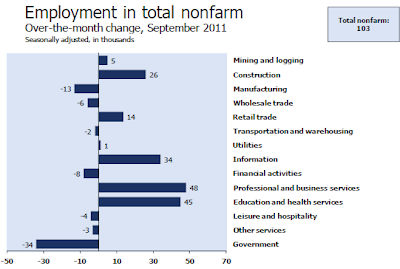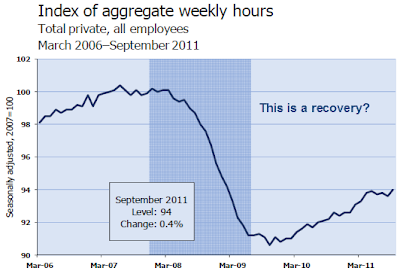Courtesy of Mish
Jobs Report at a Glance
Here is an overview of September Jobs Report, today’s release.
- US Payrolls +103,000
- 45,000 Striking Workers Return
- Net effect is +58,000 jobs
- US Unemployment Rate Flat at 9.1%
- Participation Rate +.2 to 64.2%
- Actual number of Employed (by Household Survey) rose by 398,000
- Unemployment rose by 25,000
- Those not in the labor force dropped by 224,000
- Civilian population rose by 200,000,
- Civilian Labor Force rose by 423,000
- Average Weekly Workweek rose .1 hours to 34.3 hours
- Average Private Hourly Earnings rose 3 Cents 10 $19.52
- Government employment decreased by 34,000
Recall that the unemployment rate varies in accordance with the Household Survey not the reported headline jobs number, and not in accordance with the weekly claims data.
For a change, the labor force actually rose today. This is a welcome sign. However, were it not for people dropping out of the labor force for the past two years, the unemployment rate would be well over 11%.
September 2011 Jobs Report
Please consider the Bureau of Labor Statistics (BLS) September 2011 Employment Report.
Nonfarm payroll employment edged up by 103,000 in September, and the unemployment rate held at 9.1 percent, the U.S. Bureau of Labor Statistics reported today. The increase in employment partially reflected the return to payrolls of about 45,000 telecommunications workers who had been on strike in August. In September, job gains occurred in professional and business services, health care, and construction. Government employment continued to trend down.
Unemployment Rate – Seasonally Adjusted
Nonfarm Employment – Payroll Survey – Annual Look – Seasonally Adjusted
Notice that employment is lower than it was 10 years ago.
Nonfarm Employment – Payroll Survey – Monthly Look – Seasonally Adjusted
click on chart for sharper image
Between January 2008 and February 2010, the U.S. economy lost 8.8 million jobs.
In the last year of the weakest recovery on record, 2+ years old, the economy averaged about 116,000 jobs a month.
Since April, the economy has averaged 72,000 jobs a month, a downright pathetic number.
Statistically, 127,000 jobs a month is enough to keep the unemployment rate flat.
Nonfarm Employment – Payroll Survey Details – Seasonally Adjusted
Average Weekly Hours
Index of Aggregate Weekly Hours
Average Hourly Earnings vs. CPI
"Success" of QE2
Over the past 12 months, average hourly earnings have increased by 1.9 percent. The consumer price index for all urban consumers (CPI-U) was up 3.8 percent over the year ending in August.
Not only are wages rising slower than the CPI, there is also a concern as to how those wage gains are distributed.
BLS Birth-Death Model Black Box
The BLS Birth/Death Model is an estimation by the BLS as to how many jobs the economy created that were not picked up in the payroll survey.
The BLS has moved to quarterly rather than annual adjustments to smooth out the numbers.
For more details please see Introduction of Quarterly Birth/Death Model Updates in the Establishment Survey
In recent years Birth/Death methodology has been so screwed up and there have been so many revisions that it has been painful to watch.
The Birth-Death numbers are not seasonally adjusted while the reported headline number is. In the black box the BLS combines the two coming out with a total.
The Birth Death number influences the overall totals, but the math is not as simple as it appears. Moreover, the effect is nowhere near as big as it might logically appear at first glance.
Do not add or subtract the Birth-Death numbers from the reported headline totals. It does not work that way.
Birth/Death assumptions are supposedly made according to estimates of where the BLS thinks we are in the economic cycle. Theory is one thing. Practice is clearly another as noted by numerous recent revisions.
Birth Death Model Adjustments For 2011
BLS Back in Outer-Space
Do NOT subtract the Birth-Death number from the reported headline number. That is statistically invalid.
I am nearly in shock over the negative BLS adjustment this month. The two revision months historically have been January and July. We have not see a negative number other than January or July for as long as I can remember.
Household Data
click on chart for sharper image
In the last year, the civilian population rose by 1,749,000. Yet the labor force dropped by 107,000. Those not in the labor force rose by 1,856,000.
Were it not for people dropping out of the labor force, the unemployment rate would be well over 11%.
Table A-8 Part Time Status
click on chart for sharper image
A year ago there were 8.6 million people who wanted a full-time job but could only find part-time work. In the last month, the number of people working part-time for economic reasons jumped by 444,000.
Part-time jobs are volatile but this is a huge jump.
Table A-15
Table A-15 is where one can find a better approximation of what the unemployment rate really is.
click on chart for sharper image
Distorted Statistics
Given the total distortions of reality with respect to not counting people who allegedly dropped out of the work force, it is hard to discuss the numbers.
The official unemployment rate is 9.1%. However, if you start counting all the people that want a job but gave up, all the people with part-time jobs that want a full-time job, all the people who dropped off the unemployment rolls because their unemployment benefits ran out, etc., you get a closer picture of what the unemployment rate is. That number is in the last row labeled U-6.
While the "official" unemployment rate is an unacceptable 9.1%, U-6 is much higher at 16.5%. The jump in U-6 this month is from part-time workers.
Things are much worse than the reported numbers would have you believe. Moreover, the unemployment rate is barely better than it was a year ago. It would actually be worse than a year ago were it not for people dropping out of the labor force.













